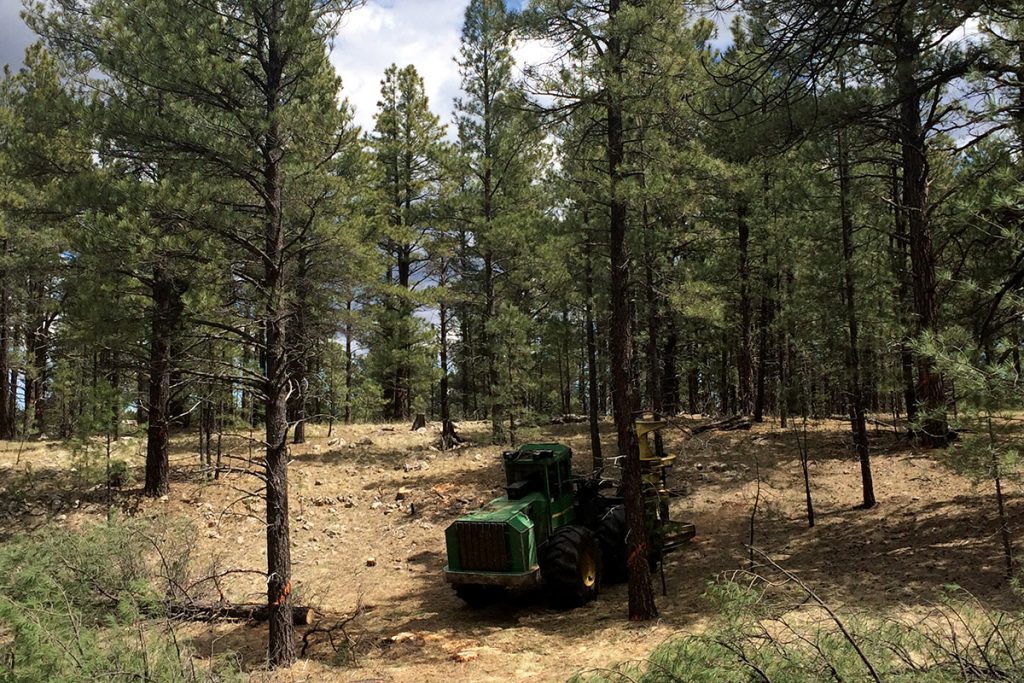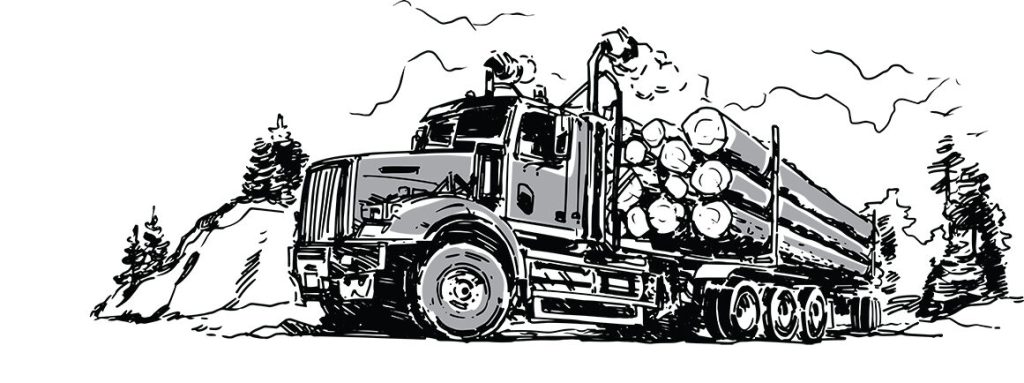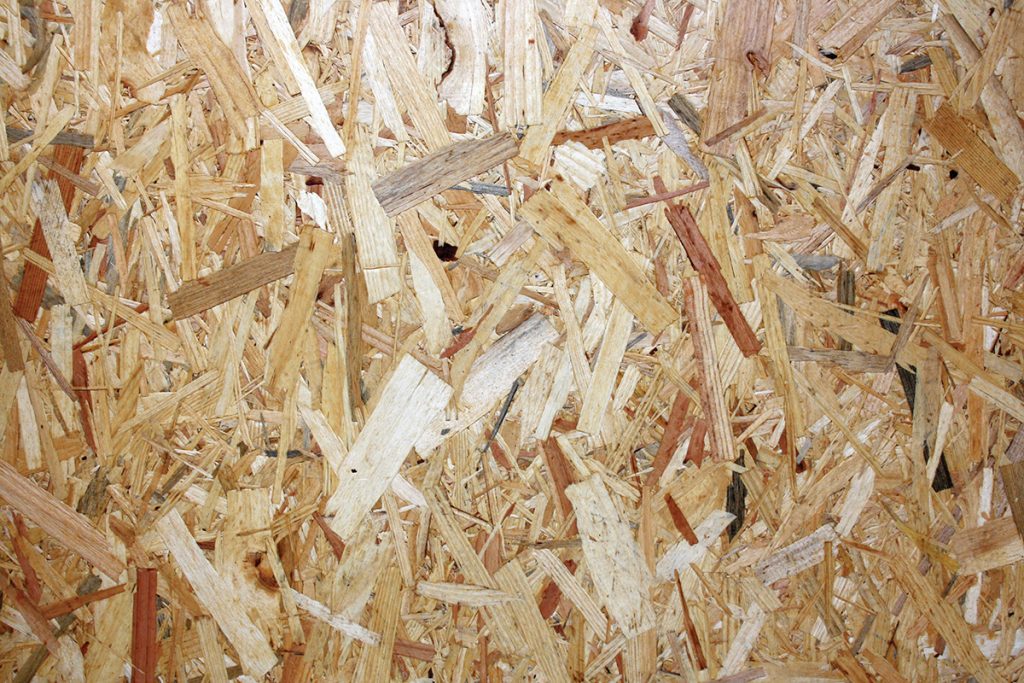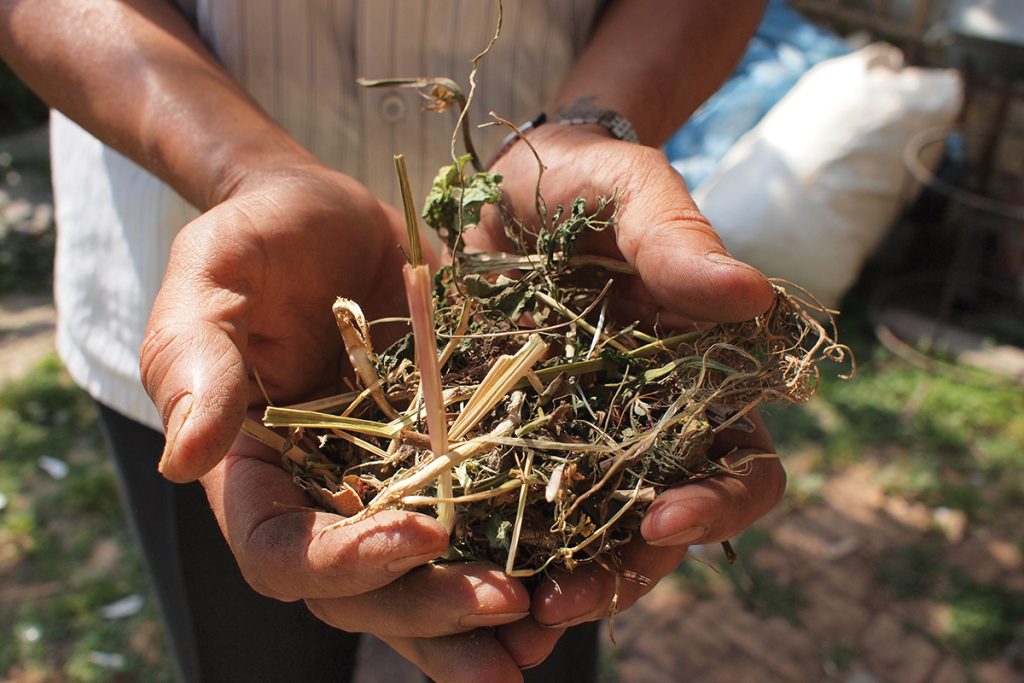Turning Fire Risk Into Financial Reward

This article from the Property and Environment Research Center (PERC), a free market environmental think tank based in Bozeman, discusses market solutions to the problematic small growth timber choking our public forests. This small but abundant timber is generally thought to have little economic value.
NOTE: this article was originally published to PERC.org on June 23, 2022. It was written by J.D. Tuccille
This special issue of PERC Reports explores the thorny issues of forest management, wildfire mitigation, and regulatory reform. Read the full issue.
Many public forests in need of restoration are overgrown with small timber. These resources hold tremendous value—if innovative markets can put them to use
It’s not often that you can double the bang for your buck, but timber markets are one of those happy exceptions. Not only do markets encourage the cultivation and use of a renewable resource, but they do so in a way that reduces wildfire risk in national forests. Giving private companies incentives to invest in the equipment and expertise needed to harvest trees that pose the most hazard during hot, dry seasons can expand the benefits and reduce the costs of this necessary process. Arizona, where I live, offers an example of how the right economic incentives can turn necessary forest management from a resource-suck into a self-sustaining creator of jobs and prosperity.
Rather than focusing on preventing wildfires on public lands, government agencies have for decades prioritized suppressing them. The result, unfortunately, has been a disruption of the natural cycle of regular fires that consumed fuel, leading to “choked forests” that have become tinderboxes. Those decades of well-intentioned mismanagement created an enormous accumulation of tinder, and clearing it out is an overwhelming job. It’s a task with which the U.S. Forest Service, responsible for 193 million acres covering 154 national forests and 20 national grasslands, can’t begin to keep pace.
“About 63 million acres,” or about a third of the land the agency manages, are “at high or very high hazard for wildfires that would be difficult to contain,” Forest Service Deputy Chief Christopher French told a U.S. Senate committee last summer. Given that the agency treats roughly 2 to 3 million acres for fire danger annually, something else needs to be done to address the highly flammable backlog. French himself emphasized the need for more “thinning, harvesting, planting, and prescribed burning across all landscapes.” Fortunately, we have models of how some of this can be accomplished. Initiatives that reduce fire danger and repurpose material from forests into marketable products can attract private companies to do the heavy lifting—if the bureaucracy can get out of the way.
Small Trees, Big Potential
A promising example of getting out of the way of market solutions can be found in Arizona. Wildfire poses danger throughout the United States, but nowhere more so than the desert Southwest, where “parched” barely begins to describe the natural state of the landscape, and vital watersheds are dependent on vast but fragile forests. Since 2010, the Four Forest Restoration Initiative (4FRI), a partnership of tribal, business, and conservation interests in northern Arizona, has worked not only to reduce the risk of wildfire but also to increase the availability of water and the wellbeing of surrounding communities.

A scene from the Four Forest Restoration Initiative (4FRI). © USFS
While the project is still exploring its potential, it has enjoyed early success; by 2021, the initiative had already treated 700,000 acres within its area of operation. But that progress almost came to a grinding halt when federal officials developed a bad case of cold feet. In September 2021, the U.S. Department of Agriculture, which houses the Forest Service, abruptly ended negotiations to extend the project. It cited “significant financial risks” and, oddly, also insisted the project was “not reasonably aligned to industry needs”—a finding better tested by business interest in the project rather than blanket statements from federal bureaucrats.
In light of the cancellation, it’s notable that reactionary environmental groups have long opposed the initiative despite the promise it holds to reduce wildfire risk. For example, the Earth Island Institute’s John Muir Project has decried 4FRI as “a massive logging project” in the past, and hostility toward commercial solutions to restore forests still prevails in some quarters. In a few high-profile instances, legal challenges or administrative objections have held up restoration projects for years, only for wildfires to destroy forests and wildlife habitat as the projects sat in limbo. Litigation risk from opponents deters the Forest Service from embracing initiatives that might be held up in court, but it especially threatens private partners that can’t afford long delays while disputes play out.
The cancellation was a particularly harsh blow after the year’s brutal fire season, which burned over a half-million acres in Arizona. It also drew immediate response from local officials. “The federal government’s lack of action is frustrating,” Arizona Governor Doug Ducey seethed over what many in the state saw as a betrayal. “The federal mismanagement of our forests poses an ongoing risk.”
At the core of 4FRI’s projects is finding profitable uses for shrubs and small-diameter trees that create extreme fire dangers. These types of vegetation serve as “ladder” files that allow flames to reach the forest canopy, where they spread rapidly and burn intensely.
Under considerable pressure, the Forest Service soon returned to discussions and hammered out a new deal in November for moving forward with a variety of projects. This was not just a victory for 4FRI but also a break from the Forest Service’s traditional phobia about long-term relationships. Barred from committing funding for more than a few years at a time—even though it can sometimes enter into 20-year stewardship contracts for “innovative use” of public lands—the agency often has to get creative to satisfy the financial side of its responsibilities. That hindrance makes partnerships with private companies even more attractive and sensible for the agency.
At the core of 4FRI’s projects is finding profitable uses for shrubs and small-diameter trees that create extreme fire dangers. These types of vegetation serve as “ladder” fuels that allow flames to reach the forest canopy, where they spread rapidly and burn intensely. In a 2007 research project, the Department of Agriculture recognized the need “to develop profitable markets for the small-diameter trees that need to be removed from overgrown forests to mitigate the risk of catastrophic forest fires.” But unless private companies know that there’s a reasonable chance of making their money back, they won’t build mills and other infrastructure needed to manufacture and ship products to end users. That’s one reason the federal government’s renewed commitment to 4FRI was so important.

It was sufficient for NewLife Forest Restoration, a sustainable forest products business that participates in 4FRI, to secure $200 million in new financing in February. The company is using the money to build out a 425,000-square-foot milling facility in Bellemont, Arizona, expand another sawmill in the state, and double the capacity of an engineered-wood plant that can repurpose fibers extracted through forest thinning. The finished products from these facilities will feed the market for softwood lumber used in housing construction.
“The company will restore 25,000 acres of forestland per year, dramatically expanding the capacity to proactively address the rising concerns of wildfire,” NewLife boasted when it announced the financing. It’s a goal unthinkable in the absence of commitments that justify investments in industrial facilities that make the venture viable.
The continuation of 4FRI and NewLife’s investment is a happy outcome, but it was a close call given the Forest Service’s near-cancellation of the project. Fortunately, those obstacles were overcome, because the small-timber markets developing in Arizona hold promise not just for that state’s forests, but also elsewhere in the country.
Many Uses
Sharon Friedman, a retired Forest Service geneticist who writes about forest policy regularly, has documented one recommended approach for dealing with an abundance of dead trees, which the agency sought to use decades ago in the 1980s: oriented strand board. The product, known as OSB, is a relatively low-cost building material that has largely replaced plywood in construction. “The problem at the time,” Friedman wrote, “was that the Forest Service couldn’t provide assurances of its share of supply.” That made the idea a nonstarter since businesses need reliable access to raw materials before putting money into facilities, workers, and equipment. The Forest Service must address its commitment issues to successfully woo private partners.
Interestingly, OSB is among the uses planned for timber products harvested by 4FRI, which has overcome the commitment hurdle. Godfrey Forest Products, one of the bidders on the second phase of the initiative, proposed placing a state-of-the-art plant in Winslow, Arizona, to manufacture the building panels. As Friedman noted in her writing, OSB can be produced from small-diameter trees and sawmill byproducts, making it a “win-win” for forest-thinning projects that seek to clear forest tinder while leaving large, healthy trees unmolested.

Oriented strand board (OSM) is a low-cost building material widely used in construction. © Lionel Allorge
Recently, demand has risen for construction products of all sorts. At one point during the summer of 2021, OSB prices had soared by 500 percent since January 2020. Of course, much of that boost can be attributed to Covid-driven supply chain disruptions involving shuttered factories, distorted demand, and snarled shipping. But demand remains strong, and lumber-based construction materials are easily produced in the United States, making them a good bet for end users hoping to avoid future chaos by keeping their sources close to home.
That’s not to say that construction supplies are the only use for small-diameter trees and other materials cleared during forest-thinning projects. Biochar, made from dead branches and woody debris, shows real promise as a soil amendment.
“While biochar is not a fertilizer, research indicates it can help retain nutrients in the soil due to its charged surface and high surface area … which allow it to adsorb nutrients like nitrogen, phosphorus, and carbon,” researchers at Michigan State University’s extension service noted in 2020. “Actually, some scientists have even found that when biochar is used in combination with compost it can retain the nutrients provided by the compost and can help decrease the need for commercial fertilizers.” That same year, federal land managers at Mt. Hood National Forest in Oregon tried their hand at incorporating biochar manufacturing into a forest-thinning project. Kraig Kidwell, regional timber contracting officer for the Forest Service, even called biochar “black gold,” adding that they were “taking a waste product and creating something usable.”
The limiting factor for biochar production was its uncompetitive price compared to fertilizer. In the intervening years, though, the economics have changed dramatically because of supply chain disruptions and international upheaval. Russia’s invasion of Ukraine in early 2022 compounded a global shortage of commercial fertilizer. The production of modern fertilizer often depends on natural gas, of which Russia is a major source, as well as potash, which is produced by Russia and its ally Belarus. Biochar may well prove to be a domestically sourced means of reducing reliance on fertilizers that have become challenging to purchase at any price.

Organic material can be used to make biochar. © Engineering for Change
If biochar has potential for reducing the need for expensive fertilizers in a wealthy country like the United States, it may be a lifesaver in developing countries that have less ability to absorb rising costs. In January, before the war in Ukraine began, high prices for fertilizer were already hurting developing-world farmers, “making it much costlier to cultivate and forcing many to cut back on production,” according to a Wall Street Journal report. “That means grocery bills could go up even more in 2022, following a year in which global food prices rose to decade highs.” A relatively inexpensive alternative to expensive fertilizers, produced from thinned forests in politically stable North America, could help to keep meals affordable to those most in need.
There’s still another use of forest debris that holds promise both in the United States and abroad: the production of wood chips for fuel at a time when energy costs are soaring around the world. For Americans, energy costs surged 32 percent in March 2022 compared to a year earlier. A 2013 report from Sustainability Solutions Services at Arizona State University specifically cited “chips and pellets for energy production” as a means of turning the thinning of small-diameter trees into a money-maker for 4FRI and similar initiatives. Forest managers in northern Arizona agreed, seeing the potential for export to fuel-poor countries even before the pandemic and conflicts over recent years made finding new sources of energy so important.

Biochar helps soil absorb nutrients and retain water. © Oregon Department of Forestry
In 2019, a pilot project led by Northern Arizona University aimed to “test the logistics and efficacy of chipping and shipping wood products via railway transportation with the goal of expanding forest product markets domestically and internationally and accelerating forest restoration efforts.” That experiment involved shipping wood chips to South Korea to substitute for coal in power plants. “If proven successful,” Arizona Department of Forestry and Fire Management Director David Tenney commented at the time, “we can potentially expand to other markets across the country and abroad.”
After the pilot, researchers from the university’s Ecological Restoration Institute concluded that, while they needed a better handle on shipping techniques and improved facilities, the approach had potential. “Additional demand for wood products could increase forest industry development, employment, and economic stability for communities,” a university report noted. “Along with these benefits,” it continued, “delivering biomass both domestically and internationally can successfully accelerate the pace and scale of restoration treatments needed to address the forest health crisis” in the United States.
Opportunity to Innovate
Producing OSB, biochar, wood chips, and other products from materials that threatened to serve as fuel for wildfires benefits not only forests, manufacturers, and end users but also the communities surrounding public lands. A 2019 analysis of 4FRI’s efforts by the Idaho-based Conservation Economics Institute found that “logging and wood utilization associated with 4FRI spur numerous good-paying jobs in the region.” The researchers found that 4FRI “has the potential to positively affect rural economies by facilitating employment and income generation with logging, wood utilization, and other restoration activities.”
That’s remarkable news for rural communities that have, in recent years, shed jobs and industry and fallen behind urban areas in terms of economic potential. Disruptions from the Covid pandemic have hit some small towns and rural areas hard, even as many were still recovering from the last recession. Innovative and profitable uses for resources from national forests promise a shot in the arm to people living in the remote and beautiful places near them. But such a boon will be available to other communities only if the Forest Service can overcome its risk aversion and resolve bureaucratic hurdles that stand in the way of committing to necessary, long-term projects.
While terrain, climate, and other specifics will vary from one location to another, ultimately, there’s no reason why the philosophy behind 4FRI couldn’t be replicated and applied to other national forests. It’s a philosophy that sees forest restoration not just as a responsibility, but also as an opportunity. It views young shrubs and small-diameter trees not just as dangers, but also as renewable resources. Active management of those resources can help maintain the health of our forests, provide affordable products for consumers at home and abroad, and create prosperity for American communities.
